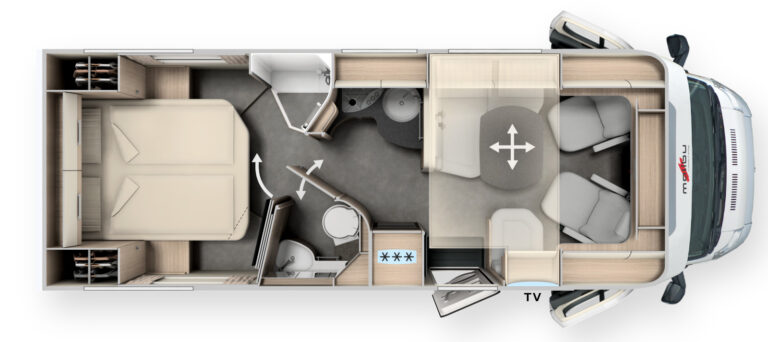Malibu T 500 RB-QB comfort 4.2 t
Malibu T 500 RB-QB comfort 4.2 t
from 96.770
GBP*
GBP*
The Malibu T 500 RB-QB has an L-shaped lounge seating area with pull-out shoe cabinet and wide, swivel-up side bench seat, comfort corner kitchen and comfort luxury bathroom with fully separable dressing room so you can enjoy the best holidays. In addition to this, there is the cosy queen-size bed with large sleeping area.
Dimensions
L 743 x B 227 x H 297 cm
Sleeping places
2 / 4 (Standard / Optional)
Sitting places
4 / 4**** (Standard / Optional)
Garage
1120 / 1240*** mm

Basic vehicleFiat Ducato
Standard chassisLow frame 40 heavy
Base engineDiesel 2,2 l
Output (in kW/HP)103 / 140
Transmission6-speed manual transmission
Total length (mm)7430
Total width (mm)2270**
Total height (mm)2970
Wheel base (mm)4035
Double floor height / double floor basement (mm)170 / 390
Headroom in living area (mm)1980
Rear garage interior height (mm)1120 / 1240***
Door width / height rear garage on passenger’s side (mm)1050 x 1100
Door width / height, rear garage on driver’s side (mm)1050 x 1100
Technically permissible gross vehicle weight (kg)4250
Weight in running order (kg) | Legal tolerance of -/+ 5 %3.143 (2.986-3.300)
Max. weight of additional equipment in series production specified by the manufacturer (kg)732
Max. towing capacity (kg)1800
Max. number of seats with 3-point / 2-point safety belt while driving4****
Standard sleeping places2
Optional sleeping places4
Rear bed dimensions (mm)1950 x 1450
Drop-down bed dimensions (mm)1890/1700 x 1100****
Seating area bed conversion dimensions (mm)1920 x 1125/650****
Fridge volume (l)153
Freezer compartment volume (l)29
Heating systemTruma Combi 6
Fresh water volume (l)125
Waste water tank volume (l)90
230V socket3
12V socket1
USB socket1
Battery capacity80 Ah
Battery capacity80 Ah
*List price incl. registration documents **Total vehicle width is the measurement from exterior wall to exterior wall (wheel arches on the side, approx.+ 70 mm) ***Pedelec scooter garage option ****in conjunction with special equipment

Find a Malibu dealer near you:
Your new camper van or motorhome are waiting for you. You just need to find out where! Find our Malibu dealers near you.

Finden Sie Ihren Malibu Händler in Ihrer Nähe:
Ihr neuer Camper Van oder Ihr neues Wohnmobil wartet schon auf Sie. Sie müssen nur wissen, wo genau. Hier finden Sie unsere Handelspartner ganz in Ihrer Nähe.